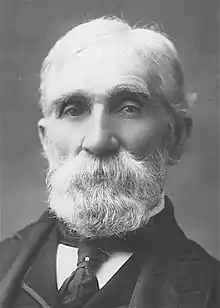Simon Fraser (Australian politician)
Sir Simon Fraser (21 August 1832 – 30 July 1919)[1] was an Australian businessman, pastoralist, and politician. He served as a Senator for Victoria from 1901 to 1913, having previously been a member of the colonial Parliament of Victoria.
Sir Simon Fraser | |
|---|---|
 | |
| Senator for Victoria | |
| In office 29 March 1901 – 30 June 1913 | |
| Member of the Victorian Legislative Council | |
| In office August 1886 – March 1901 | |
| Preceded by | James Graham |
| Succeeded by | Edmund Smith |
| Constituency | South Yarra |
| Member of the Victorian Legislative Assembly | |
| In office May 1874 – February 1883 | |
| Preceded by | John MacGregor |
| Succeeded by | James Shackell |
| Constituency | Rodney |
| Personal details | |
| Born | 21 August 1832[1] Big Brook, Nova Scotia, Canada |
| Died | 30 July 1919 (aged 86) Melbourne, Victoria, Australia |
| Political party | Protectionist (1901–06) Anti-Socialist (1906–09) Liberal (1909–13) |
| Spouse(s) | Margaret Bolger
(m. 1865–1880)Anne Collins (m. 1885) |
| Children | 5, inc. Simon Jr. |
| Relatives | Robert Collins (brother-in-law) Malcolm Fraser (grandson) |
| Occupation | Contractor, grazier |
Early life
Fraser was born on 21 August 1832 in Big Brook (now known as Lorne), a small rural township in Pictou County, Nova Scotia, Canada. He was the youngest son of Jane (née Fraser) and William Fraser. His parents shared the same surname, although no familial connection has been noted between the two. Fraser's father was born in Beauly, Inverness-shire, Scotland, and claimed descent from Clan Fraser of Lovat. He arrived in Nova Scotia in 1801, as a small child.[2]
According to Fraser, his mother spoke fluent Scottish Gaelic and one of his grandfathers spoke "very little English". In 1906, he would become the inaugural patron of the Gaelic Society of Victoria, an organisation devoted to keeping the Gaelic language and customs alive in Australia. In an address to the society, he said that he could speak only a few sentences of Gaelic, but that he could still understand most conversations.[3]
In 1839, when Fraser was seven years old, his father was killed in a sawmilling accident. He began working on the family farm at a young age, and received limited formal schooling. Attracted by the Victorian gold rush, he immigrated to Australia at the age of 21, arriving in Melbourne in 1853. He immediately went to the goldfields at Bendigo, where he turned a profit selling supplies to miners.[2]
Business career
In 1855, Fraser moved to Melbourne and opened a store on Elizabeth Street.
One of his more notable contracts was to supply ballast to the Deniliquin and Moama Railway Company, a privately owned railway which connected Moama on the Murray River to Deniliquin in southern New South Wales. Instead of supplying blue metal, Fraser supplied quartz from the slag heaps of Bendigo gold mines. It met the specifications of the contract, but was not what was expected by the owners of the railway.
Fraser later bought extensive estates in the Western District of Victoria and became a leader of the wealthy wool-growing class known as the Squattocracy.
Politics
Fraser was elected to the Victorian Legislative Assembly for the seat of Rodney in 1874, which he held until 1883. In 1886, he was elected to the Victorian Legislative Council, the traditional preserve of the squatters, representing South Yarra Province, and remained a member until 1901. He was a Minister without Portfolio from 1890 to 1892. He was a Victorian delegate to the 1894 Colonial Conference in Ottawa, and a member of the Constitutional Convention which drafted the Australian Constitution.
.jpg.webp)
In 1901, following the federation of the Australian colonies, Fraser was elected as one of the first six Victorian members of the Australian Senate, remaining a senator until his retirement in 1913. When elected he was a supporter of prime minister Edmund Barton's Protectionist Party, but he was not favourable to Barton's more liberal successor, Alfred Deakin, and sat as an independent conservative until 1909, when he joined Deakin's new Commonwealth Liberal Party, although belonging to its conservative wing. He was awarded a knighthood in the 1918 New Year Honours, becoming Sir Simon Fraser.[1]
Personal life and death
Fraser married Margaret Bolger in 1862 and had two daughters. Following her death in 1880, he married Anne Collins in 1885 and had three sons with her. His brother-in-law was Robert Martin Collins, a member of the Queensland Parliament.
One of these, (John) Neville Fraser, inherited Simon Fraser's property at Balpool in the Riverina district of New South Wales, where the future Australian Prime Minister Malcolm Fraser (1975–83) grew up. Another son, Simon, was a champion footballer and rowed for Australia in the 1912 Stockholm Olympics. Simon died just two months before his father, aged 32.
Fraser died of bronchitis on 30 July 1919, aged 86, in Melbourne. He was survived by his wife, Anne, a daughter and two sons.[4]
References
- Hawkins, Freda (1991). Critical Years in Immigration: Canada and Australia Compared. Toronto, Canada: McGill-Queen's University Press. p. 116. ISBN 0-7735-0852-X.
- Philip Ayres (1987). Malcolm Fraser: A Biography. Heinemann. p. 2. ISBN 0-85561-060-3.
- "News of the day". The Age. 3 April 1906.
- Fraser, Sir Simon (1832–1919) Obituaries Australia. Retrieved 5 October 2013]
External links
| Wikimedia Commons has media related to Simon Fraser (Australian politician). |
- Sir Simon Fraser (1832–1919) Gravesite at Brighton General Cemetery, Victoria.